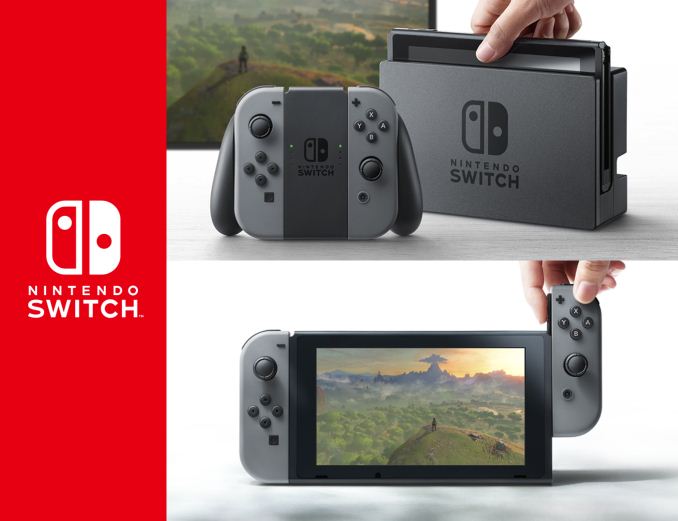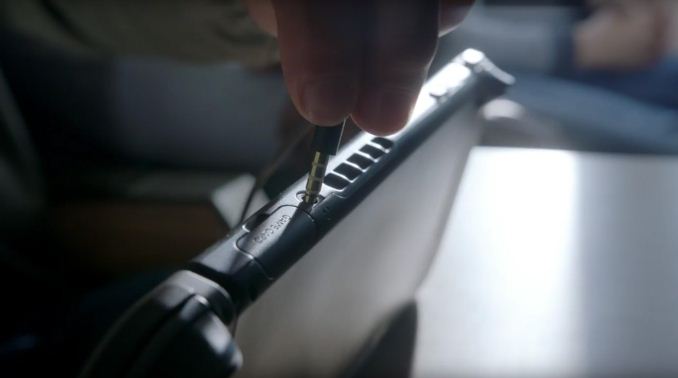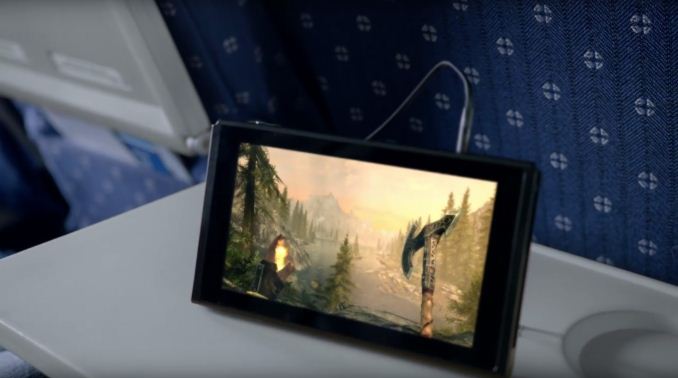Nintendo Announces Switch Portable Gaming Console - Powered by NVIDIA Tegra
by Ryan Smith on October 20, 2016 4:25 PM EST
Earlier today Nintendo took the wraps off of their next generation console, Switch. Formerly known by the codename NX, the Switch is the successor to both Nintendo’s portable DS and set top Wii console lines, utilizing a portable, tablet-like unit that can be docked to behave like a set top console. Today’s announcement, in the form of a 3 minute trailer, is meant to tease the console ahead of its full launch in March of 2017.
While I’ll skip the commentary on the console’s unusual design – dedicated gaming sites can offer better context – I wanted to dive into the hardware in the Switch. Given that this was a teaser, I was not expecting a reveal of any of the hardware specifications of the console, and indeed neither Nintendo’s teaser video nor their related press release made any mention of the underlying hardware. However shortly after the reveal went live, NVIDIA sent out an email to the press and posted a blog of their own. As it turns out, while today is still just a teaser, in some ways we’re already getting more information about the console than in any previous generation of Nintendo’s hardware.
In their blog post, NVIDIA confirmed that they would be providing the underlying SoC for the console. As this is still ultimately a teaser, NVIDIA’s own details are light, but their announcement confirms that it’s a custom version of their Tegra SoC. Curiously, no mention of the CPU core in that SoC is mentioned. However as it’s a Tegra, something ARM-based is the logical (if not only) choice. And on the GPU side, as you’d expect, they’re using a GPU based on one of NVIDIA’s existing GPU architectures, though the company isn’t specifying if it’s Pascal or Maxwell (I’d assume Pascal, but consoles are known for their long development cycles).
Otherwise, as far as specifications go that’s all we get for now. Though as NVIDIA is supplying a whole SoC there are obviously many more parts to the package that we’ll hopefully learn about in the near future. More CPU and GPU details are obviously the most interesting aspect – does the Switch SoC use Denver CPU cores? – but there’s also the matter of memory bandwidth, WiFi support, and the many other functional blocks that make up an SoC.
For NVIDIA, this is the first console hardware win for the company since the PlayStation 3, which launched in 2006. In the set top console market, AMD has since provided the GPU (and often, the CPU) for the most recent generation of consoles. Otherwise NVIDIA has never had a 3rd party portable console win, primarily because both Nintendo and Sony developed their respective SoCs internally for the 3DS and Vita.
In fact, given that Nintendo previously did much of their portable console development work internally, this is a notable shift for how the company operates. The 3DS was essentially a custom SoC combining multiple ARM11 (ARMv6) CPU cores with an OpenGL ES 1.1 generation GPU from the little-known Digital Media Professionals (DMP). So this is the first time Nintendo has contracted out their SoC needs to a third party in such a visible fashion. I’m actually a bit surprised that NVIDIA is even allowed to talk about their involvement at this point in time, given Nintendo’s historical focus on secrecy.
Though all of this also helps to underline just how big a jump in technology the Switch is from the 3DS. On the CPU side alone it’s reasonable to assume we’re looking at CPU design in the neighborhood of 4.x DMIPS/MHz, versus ARM11’s approximate 1.3 DIMPS/MHz rate, so IPC will have increased significantly, never mind an increase in frequency. Meanwhile on the GPU side, Nintendo is going from a GPU that didn’t even have a programmable GPU pipeline (i.e. shaders) to a fully modern GPU, essentially catching up on a decade of mobile GPU development in a single bound. Given that the console has to work as both the company’s portable and set top consoles, Nintendo has opted to use far more modern tech than their traditionally conservative designs.
Finally, without reading too much into a 5 paragraph announcement, there is one other interesting nugget of information in NVIDIA’s blog post that further shows just how deep the NVIDIA/Nintendo relationship is going here. Along with providing the SoC, NVIDIA also has a major stake in the development of the console’s API and middleware. While NVIDIA presumably isn’t developing the entire software stack, they make special note of the fact that they are providing a new “lightweight” API, NVN, for the console. NVIDIA is also providing middleware in the form of “a revamped physics engine, new libraries, advanced game tools and libraries” and “custom software for audio effects and rendering” which sounds a great deal like NVIDIA having brought over major parts of their GameWorks SDK, including the PhysX physics simulation libraries and VRWorks Audio library.
In any case, it will be interesting to see how this plays out over the next few months. The mobile world has changed significantly since the 3DS was launched in 2011, something that the Switch’s design makes obvious. Nintendo has gone in a very different direction than either their console rivals or the smartphone market that is always threatening to encroach on mobile consoles, and that’s reflected in both the unusual dual-mode console and the hardware inside of it.












109 Comments
View All Comments
Communism - Friday, October 21, 2016 - link
Not to mention that Nintendo happens to be a Japanese company, which means the Japanese central bank is already buying up vast quantities of their stock due to how the Japanese do their quantitative easing. And any bond that Nintendo would have to issue at any time would be instantly purchased by the Japanese central bank since the Japanese central bank buys almost all bonds in Japan.AKA, Nintendo has as much chance going bankrupt as Goldman Sachs has of going bankrupt.
KoolAidMan1 - Saturday, October 22, 2016 - link
"their first party catalog is amazing, but those releases are few and far between"And this solves that problem. All Nintendo development will be on one platform instead of split between two. Mario, Zelda, Splatoon, Pokemon, Fire Emblem, Monster Hunter, ONE PLATFORM to rule them all.
Its brilliant.
Tams80 - Sunday, October 23, 2016 - link
This. They could still have multiple devices, but it at the very least seems they are going to cartridges.Other than for great longevity, flash-based memory has now soundly passed optical media as a better format to distribute games (yes, it may still be more expensive, but it's cheap enough). This means that Nintendo could still have a very portable console, a hybrid like this, and even a home console that all use the same cartridges.
Wolfpup - Friday, October 21, 2016 - link
Nintendo's portables have pretty solid development. This'll probably have at least as much as 3DS has.It can't run the same games that the current gen consoles run, but it'll still probably end up with a strong library, AND it'll have Nintendo able to put all their development on a single console instead of splitting it, which will help too.
Yojimbo - Thursday, October 20, 2016 - link
I wonder how long this has been in the works between NVIDIA and Nintendo. It almost seems like the Shield devices were partially beta devices testing various aspects and allowing for a cost-effective method of developing the software stack. It also makes me wonder if a GeForce Now-type service will be available for the Switch at some point.Also, the Razer Edge device must have helped Nintendo in its realization of the Switch. Nintendo's system seems to add some vital flexibility to allow it to address a much larger market.
HomeworldFound - Thursday, October 20, 2016 - link
Maybe that's the idea... an insurance policy, if the Switch flops they can quickly bring in NVIDIA and/or Razer to make their own devices with exclusive Nintendo games. Then while everyone is pre-occupied with that they can create a new successful handheld while porting their games to PC or another console.webdoctors - Thursday, October 20, 2016 - link
That zelda video graphics are pretty dated. Skyrim looks great though. I hope this thing could do something like GeforceNow when plugged into the console and than local processing for 720p handheld gaming. Will see...blzd - Friday, October 21, 2016 - link
They do but keep in mind the new Zelda game seems to imploy a lot more physics than we're used to from a Nintendo game and it could be that they're focusing more of the horsepower in that regards than the typical polygons/textures. Also keep in mind that 1st party Nintendo games have traditionally always targeted 60 FPS.Flying Aardvark - Friday, October 21, 2016 - link
This is the Wii U's full potential realized. I found that we most often use the Wii U gamepad to take out of the room somewhere in the house. I'm always wishing I could take my Wii U gamepad with me outside of my home. We do not appreciate the 2nd screen for games. Nintendo seems to have figured this out too.The partnership with Nvidia is both a huge boost and worrisome. I'd take their hardware, but I'd want full rights to the source of their middleware. Next-gen Nintendo might want to look at other options and if wanting backwards compatibility, have all their old games locked to the Switch. Not a huge problem, backwards compatibility is broken often enough and perhaps NV won't try to screw them over next-gen so bad that Nintendo bails on them.
The Tegra hardware is perfect for a home/mobile device. More than enough power. No one seems to realize that good gaming has zero relation to graphics. I'd trade GTX1080 graphics power for the mobility and 2 player functionality of the Switch anyday. Can't wait to take this on my next flight.
I'll be buying one on launch and all first party Nintendo games.
Wolfpup - Friday, October 21, 2016 - link
<<<No one seems to realize that good gaming has zero relation to graphics>>>*sigh* Not this nonsense again. That's 1) completely false, and 2) more power isn't used only for better graphics.
There's plenty to like about this new system without making up ridiculous claims like that, or resorting to lame, obviously bogus Wii/Wii U apologetics.